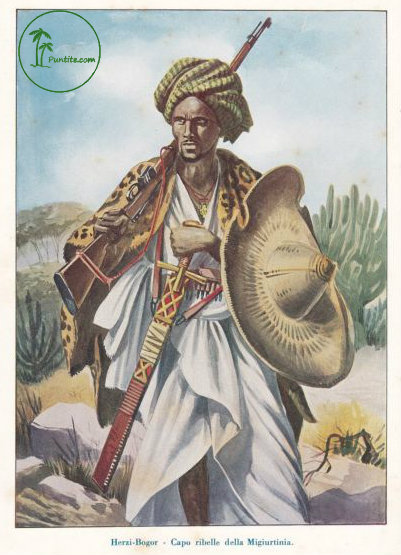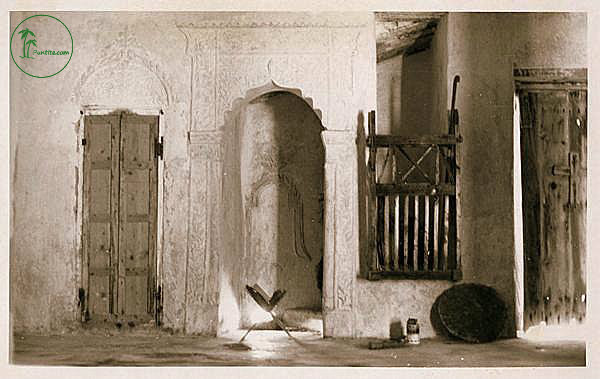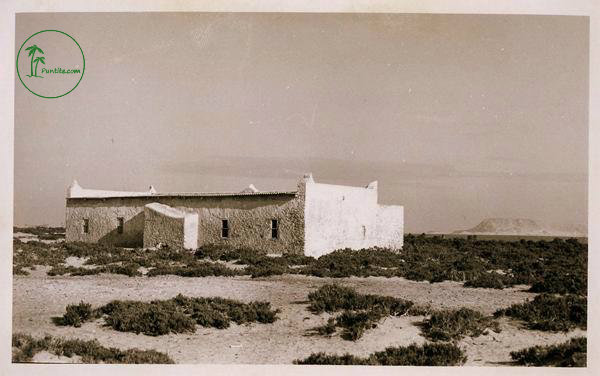
Puntland: Historical Images
Moderator: Moderators
-
Righteous
- SomaliNet Heavyweight

- Posts: 2166
- Joined: Wed Jun 04, 2014 8:21 am
- Location: Somalinet boycott by Puntites in effect 24/12/14
Re: Puntland: Historical Images
Cawaale, creator of Somalia's flag


-
Righteous
- SomaliNet Heavyweight

- Posts: 2166
- Joined: Wed Jun 04, 2014 8:21 am
- Location: Somalinet boycott by Puntites in effect 24/12/14
Re: Puntland: Historical Images
Righteous wrote:"Sheikh Ali Abdirahman Fiqikheyre later in his lifetime to be known as Sheikh Ali Majeerteen was born in the Nugaal valley to a Majeerteen father and an Ajuuraan mother in the early 1800s. He would later become one of the culimo of that time who made a great contribution to educating the Somali people of the deen.
He embarked on the obligatory Hajj trip to Mecca, passing through Yemen and overcoming the harsh journey through the Arabian deserts to the holy city of Mecca. When he arrived, as was usually the case, the Arab guards discriminated against him out of racism and refused to let him enter.
Haji Ali immediately sent a letter to the leader of the second Saudi state at the time, Emir Faisal ibn Turki, the grandfather of the founder of modern Saudi Arabia, King Abdul Aziz ibn Abdulrahman ibn Faisal. The letter was written in Arabic in its most purest dialect as a poem.
Upon reading the letter, the Emir became furious about the situation this fellow brother all the way from Somalia was in and angrily ordered the guards of the Haramka mosque to let the Somali brother enter at once and do his deeds to Allah. When Haji Ali completed his Hajj, the Emir requested to meet the young man from Somalia who write him so eloquently.
When the Emir and the young Haji met each other, as is the custom to both Arabs and Somalis, the Emir enquired him about his lineage. Haji Ali responded with a beautiful Arabic poem, showcasing the present Arabs at the venue of the nobility of his heritage. He later translated the poem into Somali:
Baha baha hadday tahay bahda Haajiraan ahay
Binu Cuqayl biyaha Jeberti nin ka beermay baan ahay
Daarood bartiisiyo beerkiyo laftaan ahay
Dadku baari kala roone baafane Hartaan ahay
Majeerteenka sida buurta u ballaartay baan ahay
Cumarkaas(Reer Cumar) burhaantiis bogga loo geshaan ahay
Boqorku waa Jibraahiile anna baashigaan ahay.
The Emir, impressed as he was with this black man's grasp of the Arabic language and poetry without ever having set foot in the Arabian peninsula before, prompted him to allocate Haji Ali with a large plot of land. This would mark the beginning of the Sheikh's journey to the rest of the Arabian peninsula and more importantly the rest of his country Somalia, especially the south where he has educated many about the deen.
To this day there is a very old mosque in Oman, where the Omanis upong seeing your Somali appearance will tell you about a strong Somali man who has helped them build the mosque by providing it with large logs of wood carried all the way up to the ceiling. The giant pieces of wood have Haji Ali's name engraved in it.
Haji Ali's history is rather long and cannot be summarized into one thread"
- STARKAST
- SomaliNet Super

- Posts: 5153
- Joined: Mon Aug 03, 2009 11:07 am
- Location: Bale mountains, Somali Galbeed
Re: Puntland: Historical Images
Mashah'Allah nice post about him, btw what sub clan was he ? isse muhammed ?
-
Righteous
- SomaliNet Heavyweight

- Posts: 2166
- Joined: Wed Jun 04, 2014 8:21 am
- Location: Somalinet boycott by Puntites in effect 24/12/14
Re: Puntland: Historical Images
No, he's Reer Cumar, not to be mistaken for Cumar Maxamoud, they're an old Majeerteen sub clan.STARKAST wrote:Mashah'Allah nice post about him, btw what sub clan was he ? isse muhammed ?
- STARKAST
- SomaliNet Super

- Posts: 5153
- Joined: Mon Aug 03, 2009 11:07 am
- Location: Bale mountains, Somali Galbeed
Re: Puntland: Historical Images
ohh ok nice story btw heard of him.Righteous wrote:No, he's Reer Cumar, not to be mistaken for Cumar Maxamoud, they're an old Majeerteen sub clan.STARKAST wrote:Mashah'Allah nice post about him, btw what sub clan was he ? isse muhammed ?
- STARKAST
- SomaliNet Super

- Posts: 5153
- Joined: Mon Aug 03, 2009 11:07 am
- Location: Bale mountains, Somali Galbeed
Re: Puntland: Historical Images
what is reer cumar bro ?
-
Righteous
- SomaliNet Heavyweight

- Posts: 2166
- Joined: Wed Jun 04, 2014 8:21 am
- Location: Somalinet boycott by Puntites in effect 24/12/14
Re: Puntland: Historical Images
Reer Cumar of the Umad Nebi sub clan. Majeerteen are massive bro. I can't list all the tribes.STARKAST wrote:what is reer cumar bro ?
- STARKAST
- SomaliNet Super

- Posts: 5153
- Joined: Mon Aug 03, 2009 11:07 am
- Location: Bale mountains, Somali Galbeed
Re: Puntland: Historical Images
oh okay thanks. gartey
-
Righteous
- SomaliNet Heavyweight

- Posts: 2166
- Joined: Wed Jun 04, 2014 8:21 am
- Location: Somalinet boycott by Puntites in effect 24/12/14
Re: Puntland: Historical Images
Hersi Boqor, Prince of Majeerteenia, and the battle with the EY-Talians.

In December 1925, led by the charismatic leader Hersi Boqor, son of Boqor Cusmaan, the sultanate forces drove the Italians out of Hurdiyo and Hafun, two strategic coastal towns. Another contingent attacked and destroyed an Italian communications center at Cape Guardafui, at the tip of the Horn. In retaliation, and to demoralize the resistance, Italian warships were ordered to target and bombard the sultanate’s coastal towns and villages. In the interior the Italian troops confiscated livestock.
After a violent confrontation Italian forces captured Eyl, which until then had remained in the hands of Hersi Boqor. In response to the unyielding situation, Italy called for reinforcements from their other colonies, notably Eritrea. With their arrival at the closing of 1926, the Italians began to move into the interior where they had not been able to venture since their first seizure of the coastal towns. Their attempt to capture the Dharoor Valley was resisted, and ended in failure.
De Vecchi, the governor of Italian Somaliland, had to reassess his plans as he was being humiliated on many fronts. After one year of exerting full force he could not yet manage to gain total control over the sultanate. In spite of the fact that the Italian navy sealed the sultanate’s main coastal entrance, they could not succeed in stopping them from receiving arms and ammunition through it. It was only early 1927 when they finally succeeded in shutting the northern coast of the sultanate, thus cutting arms and ammunition supplies for Migiurtinia. By this time, the balance had tilted to the Italians’ side, and in January 1927 they began to attack with massive force, capturing Iskushuban, at the heart of Migiurtinia. Hersi Boqor unsuccessfully attacked and challenged the Italians at Iskushuban. By the end of the 1927, the Italians had nearly taken control of the sultanate. Hersi Boqor and his troops retreated to Ethiopia in order to rebuild their forces, but were unable to retake their territories, effectively ending the Campaign of the Sultanates. Migiurtinia was the last region to fall to the Italian colonists.

In December 1925, led by the charismatic leader Hersi Boqor, son of Boqor Cusmaan, the sultanate forces drove the Italians out of Hurdiyo and Hafun, two strategic coastal towns. Another contingent attacked and destroyed an Italian communications center at Cape Guardafui, at the tip of the Horn. In retaliation, and to demoralize the resistance, Italian warships were ordered to target and bombard the sultanate’s coastal towns and villages. In the interior the Italian troops confiscated livestock.
After a violent confrontation Italian forces captured Eyl, which until then had remained in the hands of Hersi Boqor. In response to the unyielding situation, Italy called for reinforcements from their other colonies, notably Eritrea. With their arrival at the closing of 1926, the Italians began to move into the interior where they had not been able to venture since their first seizure of the coastal towns. Their attempt to capture the Dharoor Valley was resisted, and ended in failure.
De Vecchi, the governor of Italian Somaliland, had to reassess his plans as he was being humiliated on many fronts. After one year of exerting full force he could not yet manage to gain total control over the sultanate. In spite of the fact that the Italian navy sealed the sultanate’s main coastal entrance, they could not succeed in stopping them from receiving arms and ammunition through it. It was only early 1927 when they finally succeeded in shutting the northern coast of the sultanate, thus cutting arms and ammunition supplies for Migiurtinia. By this time, the balance had tilted to the Italians’ side, and in January 1927 they began to attack with massive force, capturing Iskushuban, at the heart of Migiurtinia. Hersi Boqor unsuccessfully attacked and challenged the Italians at Iskushuban. By the end of the 1927, the Italians had nearly taken control of the sultanate. Hersi Boqor and his troops retreated to Ethiopia in order to rebuild their forces, but were unable to retake their territories, effectively ending the Campaign of the Sultanates. Migiurtinia was the last region to fall to the Italian colonists.
-
Righteous
- SomaliNet Heavyweight

- Posts: 2166
- Joined: Wed Jun 04, 2014 8:21 am
- Location: Somalinet boycott by Puntites in effect 24/12/14
Re: Puntland: Historical Images
Ruins of an Ancient Mosque, Hurdiyo




Re: Puntland: Historical Images
Yup, I have indeed heard Sheikh Ali Majeerteen and the good things he has done to spread the deen, especially in Southern Somalia to other parts in Africa. We need the Sheikh's history collected into a book so the current and future generations can benefit.Righteous wrote:Righteous wrote:"Sheikh Ali Abdirahman Fiqikheyre later in his lifetime to be known as Sheikh Ali Majeerteen was born in the Nugaal valley to a Majeerteen father and an Ajuuraan mother in the early 1800s. He would later become one of the culimo of that time who made a great contribution to educating the Somali people of the deen.
He embarked on the obligatory Hajj trip to Mecca, passing through Yemen and overcoming the harsh journey through the Arabian deserts to the holy city of Mecca. When he arrived, as was usually the case, the Arab guards discriminated against him out of racism and refused to let him enter.
Haji Ali immediately sent a letter to the leader of the second Saudi state at the time, Emir Faisal ibn Turki, the grandfather of the founder of modern Saudi Arabia, King Abdul Aziz ibn Abdulrahman ibn Faisal. The letter was written in Arabic in its most purest dialect as a poem.
Upon reading the letter, the Emir became furious about the situation this fellow brother all the way from Somalia was in and angrily ordered the guards of the Haramka mosque to let the Somali brother enter at once and do his deeds to Allah. When Haji Ali completed his Hajj, the Emir requested to meet the young man from Somalia who write him so eloquently.
When the Emir and the young Haji met each other, as is the custom to both Arabs and Somalis, the Emir enquired him about his lineage. Haji Ali responded with a beautiful Arabic poem, showcasing the present Arabs at the venue of the nobility of his heritage. He later translated the poem into Somali:
Baha baha hadday tahay bahda Haajiraan ahay
Binu Cuqayl biyaha Jeberti nin ka beermay baan ahay
Daarood bartiisiyo beerkiyo laftaan ahay
Dadku baari kala roone baafane Hartaan ahay
Majeerteenka sida buurta u ballaartay baan ahay
Cumarkaas(Reer Cumar) burhaantiis bogga loo geshaan ahay
Boqorku waa Jibraahiile anna baashigaan ahay.
The Emir, impressed as he was with this black man's grasp of the Arabic language and poetry without ever having set foot in the Arabian peninsula before, prompted him to allocate Haji Ali with a large plot of land. This would mark the beginning of the Sheikh's journey to the rest of the Arabian peninsula and more importantly the rest of his country Somalia, especially the south where he has educated many about the deen.
To this day there is a very old mosque in Oman, where the Omanis upong seeing your Somali appearance will tell you about a strong Somali man who has helped them build the mosque by providing it with large logs of wood carried all the way up to the ceiling. The giant pieces of wood have Haji Ali's name engraved in it.
Haji Ali's history is rather long and cannot be summarized into one thread"
Re: Puntland: Historical Images
jamal9 wrote:



- Halmog
- SomaliNetizen

- Posts: 908
- Joined: Thu Jun 27, 2013 1:14 pm
- Location: I LIKE THE WAY YOU DIE BOY
Re: Puntland: Historical Images
Don't ruin the thread fadlan
Re: Puntland: Historical Images
 GALDOGOB
GALDOGOB GALDOGOB
GALDOGOB GALDOGOB
GALDOGOB GALDOGOB
GALDOGOB GALDOGOB
GALDOGOB-
- Similar Topics
- Replies
- Views
- Last post
-
- 33 Replies
- 15751 Views
-
Last post by zingii
-
- 33 Replies
- 18335 Views
-
Last post by The_Patriot
-
- 23 Replies
- 10471 Views
-
Last post by Xamud.
-
- 13 Replies
- 2108 Views
-
Last post by TheblueNwhite
-
- 2 Replies
- 996 Views
-
Last post by Righteous
-
- 1 Replies
- 442 Views
-
Last post by theyuusuf143
-
- 0 Replies
- 799 Views
-
Last post by BestPlaya
-
- 27 Replies
- 22437 Views
-
Last post by Somaliman50
-
- 89 Replies
- 76855 Views
-
Last post by TheblueNwhite
-
- 1 Replies
- 9495 Views
-
Last post by Ducaysane_87




